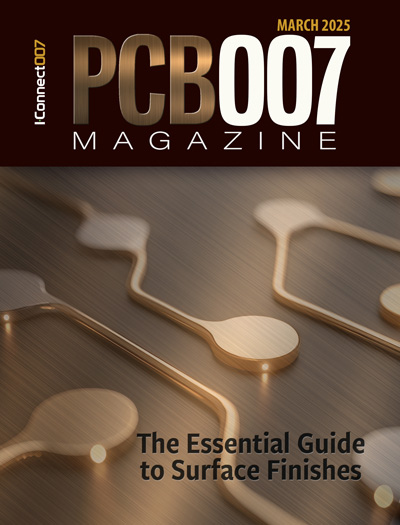-

- News
- Books
Featured Books
- pcb007 Magazine
Latest Issues
Current Issue
In Pursuit of Perfection: Defect Reduction
For bare PCB board fabrication, defect reduction is a critical aspect of a company's bottom line profitability. In this issue, we examine how imaging, etching, and plating processes can provide information and insight into reducing defects and increasing yields.

Voices of the Industry
We take the pulse of the PCB industry by sharing insights from leading fabricators and suppliers in this month's issue. We've gathered their thoughts on the new U.S. administration, spending, the war in Ukraine, and their most pressing needs. It’s an eye-opening and enlightening look behind the curtain.

The Essential Guide to Surface Finishes
We go back to basics this month with a recount of a little history, and look forward to addressing the many challenges that high density, high frequency, adhesion, SI, and corrosion concerns for harsh environments bring to the fore. We compare and contrast surface finishes by type and application, take a hard look at the many iterations of gold plating, and address palladium as a surface finish.
- Articles
- Columns
Search Console
- Links
- Media kit
||| MENU - pcb007 Magazine
How to Become a Certified IPC Trainer
December 27, 2019 | Blackfox Training InstitiuteEstimated reading time: 1 minute
Certified Trainer Programs are intended for those who wish to become certified as instructors in different IPC specifications for the electronic assembly industry. This includes training, the supply of IPC-based instructional materials, and subsequent certification of successful candidates. Written exams are also provided throughout the course to test the candidates and ensure that they fully understand the material.
The Blackfox Certified IPC Trainer (CIT) programs are best suited for experienced and skilled electronics technicians, engineers, and supervisors who have the will and passion to teach and train colleagues about the quality standards of IPC. They also provide successful candidates with a credential that confirms their knowledge and understanding of IPC quality systems.
The IPC instructor level courses and certifications are useful to individuals working in companies, independent consultancy firms, and training institutions. All of these are part of IPC’s “train-the-trainer” program, which makes successful candidates eligible to conduct CIS training and certify successful trainees.
These are the most widely recognized CIT instructor certification standards published by IPC:
• IPC-A-610 Certified IPC Trainer (CIT) Acceptability of Electronic Assemblies
• IPC J-STD-001 Certified IPC Trainer (CIT) Requirements for Soldered Electrical and Electronic Assemblies
• IPC-7711/7721 Certified IPC Trainer (CIT) Rework of Electronic Assemblies and Repair and Modification of Printed Boards and Assemblies
• IPC-A-600 Certified IPC Trainer (CIT) Acceptability of Printed Circuit Boards
• IPC/WHMA-A-620 Certified IPC Trainer (CIT) Requirements and Acceptance for Cable and Harness Assemblies
• IPC-6012 Certified IPC Trainer (CIT) Qualification and Performance Specification for Rigid Boards
Who Can Qualify for the Certified IPC Trainer Course?
Anyone whose responsibility lies in the quality, acceptability, and reliability of assemblies—including quality assurance engineers and manufacturing supervisors—can qualify for this CIT training course. Candidates for the certification for IPC instructor courses typically come from electronic manufacturing companies and original equipment manufacturers who want their key people to receive intensive training. Once they have completed their course and passed the exams, each candidate is awarded a certification. Each CIT certification has a validity of two years after the completion date. Certified IPC Trainers whose certifications have expired are no longer authorized to conduct IPC training until they are recertified by an IPC authorized training center. Give your employees the opportunity to expand their ability and understanding of IPC quality standards by sending them to a CIT course.
Suggested Items
IPC Applauds Leadership of Reps. Moore and Krishnamoorthi on PCB Manufacturing Bill
05/28/2025 | IPCIPC, the global electronics association serving more than 1,400 U.S. companies and over 3,200 worldwide, strongly supports the bipartisan reintroduction of the Protecting Circuit Boards and Substrates (PCBS) Act in the 119th Congress.
AT&S Strengthens European Research at IPCEI Day
05/26/2025 | AT&SWith the IPCEI program, the European Union supports companies that make important contributions to the technological development of key industries on the old continent.
LSI ADL Technology Leverages IPC Membership for Growth, Training, and Industry Leadership
05/28/2025 | Michelle Te, IPC CommunityWhether attending the EMS Leadership Summit at IPC APEX EXPO, or subscribing to workforce training, LSI ADL Technology has noted several positive changes directly related to its IPC membership. “Collaboration, brainstorming, and sharing best practices have been the most important aspects of our partnership with IPC,” says Jonathan Verity, assistant general manager at LSI ADL Technology.
Tax Policy Update from IPC: The House Tax Bill, and What It Means for Electronics Manufacturers
05/20/2025 | IPCOn May 13, the House Ways and Means Committee advanced a major tax package that includes several provisions supported by IPC. These provisions—including restoring bonus depreciation, immediate R&D expensing, and strengthening the pass-through deduction—were identified by IPC members as key tools that would help them invest, grow, and compete more effectively.
Zero Touch Data Package: The Future of Seamless PCB Manufacturing
05/22/2025 | Dana Korf, Victory Giant TechnologyImagine a day when a design data file—not a traditional documentation package—is output directly from the eCAD system, transmitted to selected fabricators, and automatically loaded into their engineering/CAM systems, initiating tooling and production without any human intervention. This is zero touch data transfer in action. By eliminating manual processes, front-end personnel at fabrication facilities can be redeployed to strategic areas such as R&D and customer engagement.


